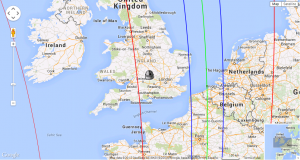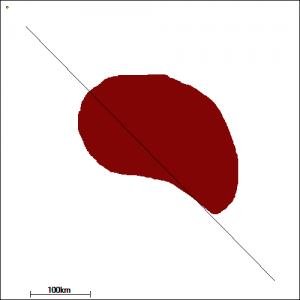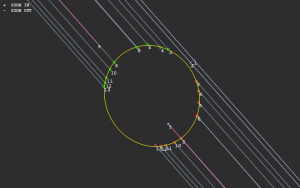This was my 6th positive asteroid occultation and my 1st of 2015. It featured a faint star (mag. 10.6) in Auriga and the large asteroid (81) Terpsichore. The Moon was a very thin crescent only 7% illuminated and 15° above the SW horizon. It was my longest duration occultation so far.
- Predicted event time was 17:53:34 ±62s UTC for my observing position.
- Predicted maximum duration was 32.8 seconds with a 1.9 magnitude drop.
- Position was 285km west from the predicted central line in the 1-sigma zone, 196km outside the shadow path.
- Calculated probability of seeing the occultation was 14.3%.

In the map above the predicted shadow zone is between the blue lines, the predicted centre of the occultation is the green line. The red lines indicate the 1-sigma zone. The location of my station is shown by the observatory icon.
I recorded 80ms integrations using a Watec 910HX video camera on a 300mm F/4 Newtonian telescope. Video was captured via a USB2 capture device on a laptop with VirtualDub software. I used a timestamp from a Blackbox GPS video time inserter. I recorded for six minutes centred on the predicted occultation time.
The occultation occurred about a minute earlier than the prediction but within the expected error. Here is a short clip of the recorded video showing the occultation. The occulted star is near the centre. It’s actually a close double star and you can see the primary star diminish in magnitude so that only the asteroid and secondary star are visible.
This is the light curve for the event from video analysis in AOTA (Asteroidal Occultation Time Analyser).

Nb. the timings below are corrected for internal delays in the camera and for the integration period in accordance with G. Dangl.
| Start | 17:52:33.07 | ±0.04s |
| End | 17:52:56.59 | ±0.04s |
| Duration | 23.52s | ±0.08s |
There were no other successful observations of this occultation. My chord gives a minimum diameter of the asteroid of 96km.
Interestingly the ingress of the occultation was instantaneous whereas the egress was far more gradual, taking over a second before the light from the star recovered to pre-occultation levels. After posing the question on the Planoccult mailing list Eric Frappa kindly explained why this can occur.
Such light curve can be produced by an asteroid border perpendicular to the star path on one side and with a narrow angle on the other side – as drawn below using Dave’s Light curve simulator (imaginary profile and its corresponding curve).
Compare this simulated curve with the one I observed above.
There have been five previous successful observations of Terpsichore occulting stars. The most successful was on 25th December 2009 when 10 out of 12 observers in California observed a positive occultation giving a decent profile of the asteroid.
The yellow ellipse is a best fit to the data, remember this is only one snapshot of the asteroid in a particular orientation.


